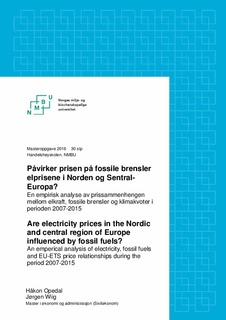Påvirker prisen på fossile brensler elprisene i Norden og Sentral-Europa? En empirisk analyse av prissammenhengen mellom elkraft, fossile brensler og klimakvoter i perioden 2007-2015
Master thesis
Permanent lenke
http://hdl.handle.net/11250/2404226Utgivelsesdato
2016-09-05Metadata
Vis full innførselSamlinger
- Master's theses (HH) [1072]
Sammendrag
Vi studerer prissammenhenger mellom kull, gass, CO2 kvoter og elpriser i Norden og Sentral-Europa gjennom perioden 2007-2015. Fossile brensler utgjør en betydelig større andel av den totale kraftproduksjonen i det sentral-europeiske markedet sammenliknet med det nordiske.
Hensikten med oppgaven er derfor å avdekke om prisendringer på kull, gass og CO2 kvoter har noen påvirkning på systemprisen på Nord Pool og EPEX. Vi innleder analysen med å studere korrelasjoner mellom prisendringer i råvarene. Videre ser vi på lead-lag relasjoner, med den hensikt å undersøke hvorvidt prisendringer i råvarene påvirker elprisene på et senere tidspunkt. Vi beregner clean dark og spark spread for å kunne identifisere perioder der det er rimelig å anta at kull og gasskraftverkene er operative. Avslutningsvis vurderer vi om det eksisterer et langsiktig likevekts forhold mellom systemprisene og råvarene, som vil muliggjøre modellering av den kortsiktige dynamikken i markedene.
Vi finner statistiske bevis på at det eksisterer kointegrerte forhold mellom systemprisen og råvarene i begge markedene. Ved en større prisendring i kull og gass, justerer systemprisen på EPEX seg raskere mot likevektsnivået sammenliknet med Nord Pool. Vi observerer at nivået på de variable produksjonskostnadene i kullkraftverkene er en signifikant driver for systemprisen i perioder med høy etterspørsel på Nord Pool og EPEX. Tilsvarende signifikante parameter estimater observeres for de variable produksjonskostnadene i gasskraftverkene innad EPEX systemet. Det vil følgelig være kraftverk med høyest variabel produksjonskostnad som vil være prissettende i perioder med høy etterspørsel. Resultatene gir videre en indikasjon på at ending i kull og gasspriser gir større utslag i det sentral-europeiske markedet sammenliknet med det nordiske. We
are
studying
the
price
relationships
between
coal,
gas,
CO2
quotas
and
electricity
prices
in
Nordic
countries
and
Central
Europe
in
the
time
period
2007-‐2015.
Fossil
fuels
make
up
a
more
considerable
share
of
energy
production
in
the
European
market
compared
to
Nordic
countries.
The
purpose
of
this
paper
is
hence
to
uncover
if
the
price
fluctuations
of
coal,
gas,
and
CO2
quotas
have
any
effect
on
the
electricity
price
on
Nord
Pool
and
EPEX.
We
will
begin
the
analysis
by
studying
correlations
between
changes
in
the
electricity
price
and
the
cost
of
raw
materials.
Then,
we
will
address
lead-‐lag
relations
in
order
to
investigate
whether
price
fluctuations
related
to
raw
materials
have
an
effect
on
electricity
prices
at
a
later
time.
From
this,
we
can
calculate
clean
dark
and
spark
spread
which
enables
us
to
identify
periods
of
time
where
it
is
reasonable
to
assume
that
coal
and
gas
production
is
in
operation.
Finally,
we
will
examine
whether
there
is
a
long-‐term,
reciprocal
equilibrium
between
system
costs
and
the
raw
materials,
which
will
establish
a
means
of
modelling
short-‐term
dynamics
in
the
markets.
There
is
statistical
evidence
that
there
is
co-‐integrated
relationships
between
the
electricity
price
and
the
price
of
raw
materials
in
both
markets.
In
the
case
of
a
major
price
fluctuation
in
oil
and
gas,
the
electricity
price
on
EPEX
will
adjust
more
quickly
towards
equilibrium
compared
with
Nord
Pool.
Further
analysis
shows
that
the
level
of
variability
of
production
costs
in
coal-‐fired
power
stations
is
a
significant
factor
to
the
electricity
price
in
times
of
high
demand
for
both
Nord
Pool
and
EPEX.
Similar
significant
parameter
estimates
can
also
be
observed
in
the
varying
production
costs
of
gas
within
the
EPEX
system.
Therefore,
it
is
the
power
plants
with
the
highest
marginal
production
cost
which
set
the
prices
in
times
of
high
demand.
The
results
will
be
an
indication
that
fluctuations
in
the
coal
and
gas
price
will
have
a
more
significant
effect
on
Central-‐European
markets
in
relation
to
the
Nordic
market.
